This post contains affiliate links.
Al works as a carpenter and Jessica works in PR, but when they come home at night, it’s to a cozy 55-foot-long narrowboat moored somewhere along the canalways of London.
Their narrowboat lifestyle allows them to live with a lower carbon footprint and get closer to nature, while still living in the city — the best of both worlds! And month-to-month their expenses are less than renting, although big-time expenses do pop up (like, you know, a new engine!).
While they’ve owned “Peace Frog” now for two years, they spent time on land after a fire burnt much of the boat, requiring a full renovation inside. That said, the renovation has made this boat quite gorgeous and homey! Jessica shares her tiny living story at the end of the photo tour, so be sure to read it! You can follow them on Instagram here.
Don’t miss other interesting tiny homes – join our FREE Tiny House Newsletter for more!
Off-Grid on the London Canalways: Peace Frog
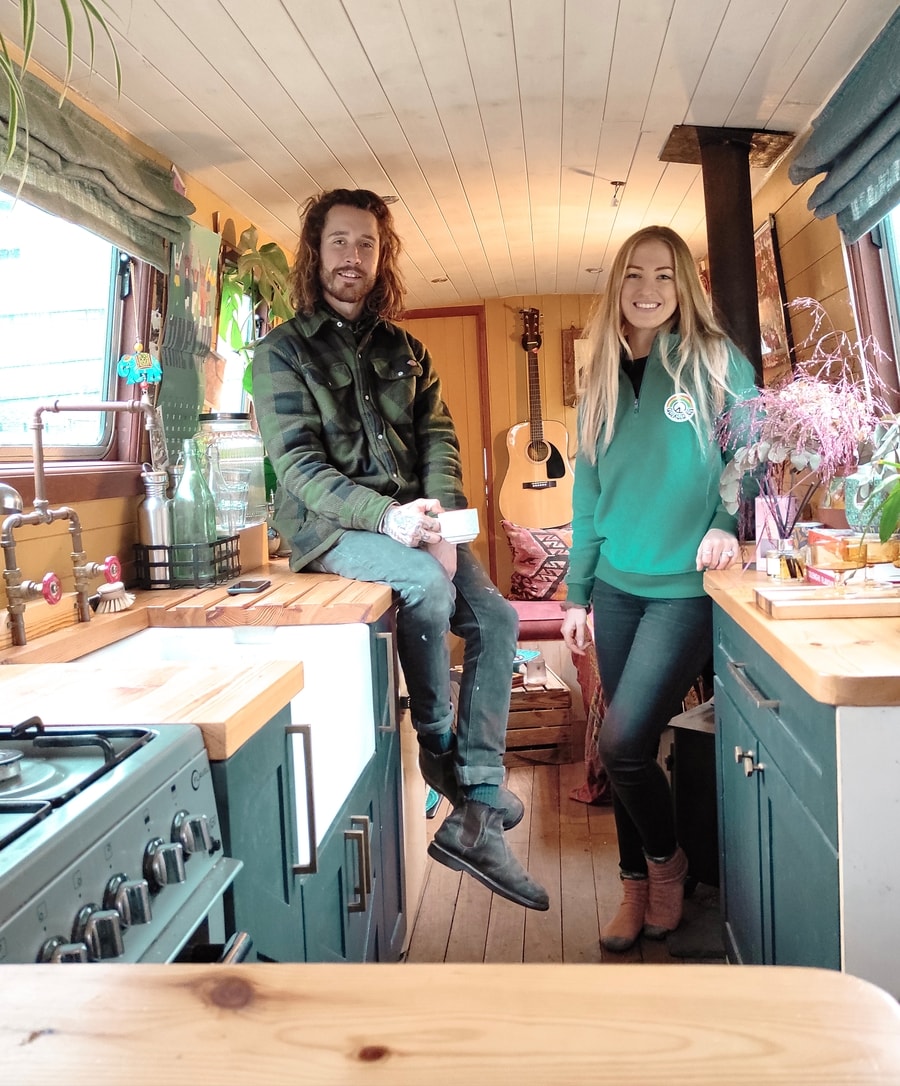
Images via @wood_and_water_blog/Instagram
Finding a spot to rest for the night.
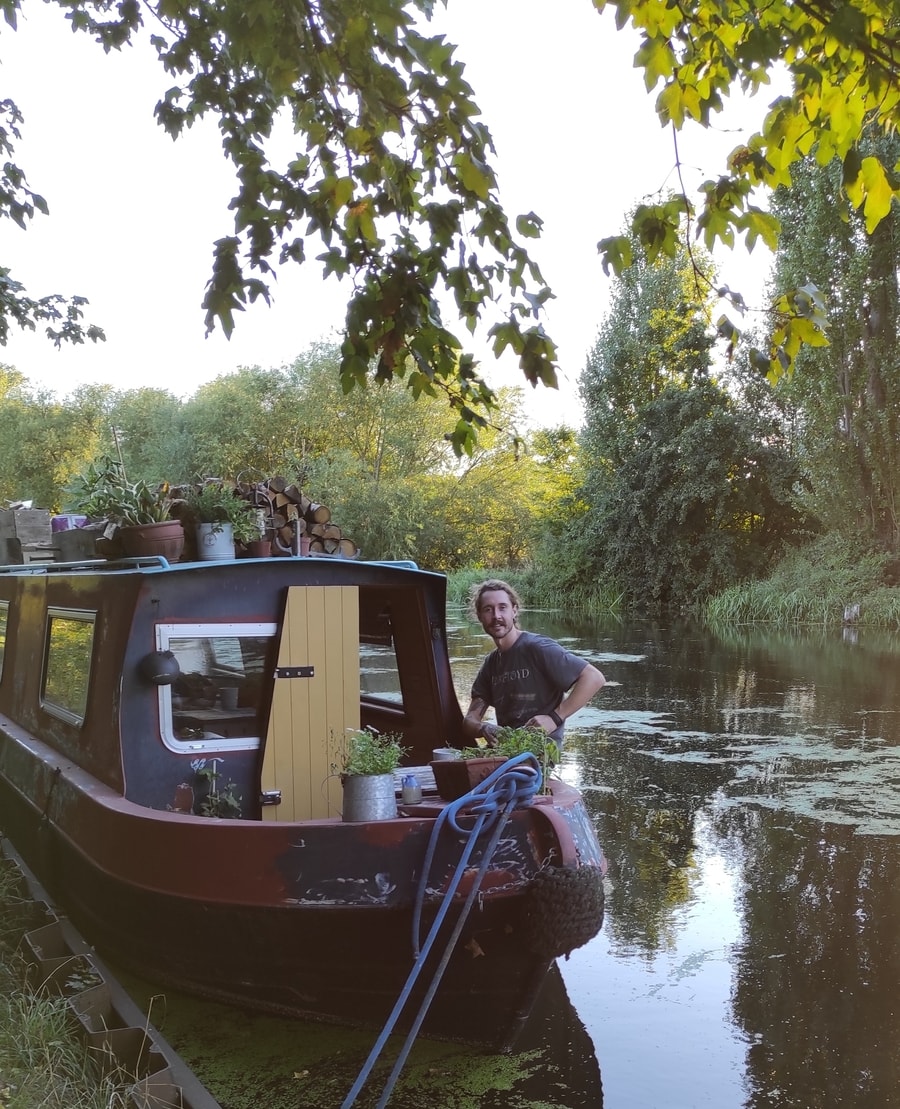
Images via @wood_and_water_blog/Instagram
A gorgeous tiny kitchen. Love the cabinet color.

Images via @wood_and_water_blog/Instagram
The dinette gets plenty of natural light.
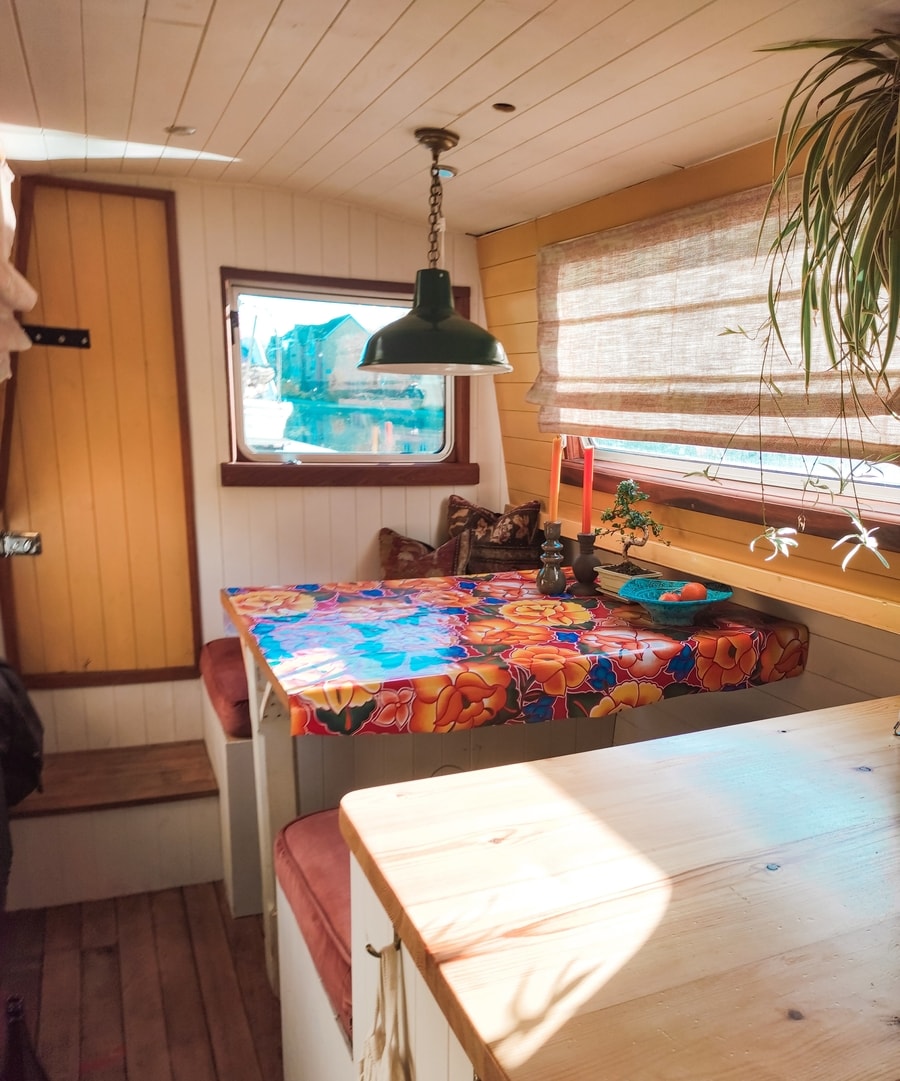
Images via @wood_and_water_blog/Instagram
The farmhouse sink and rustic pipe faucet complete the look.
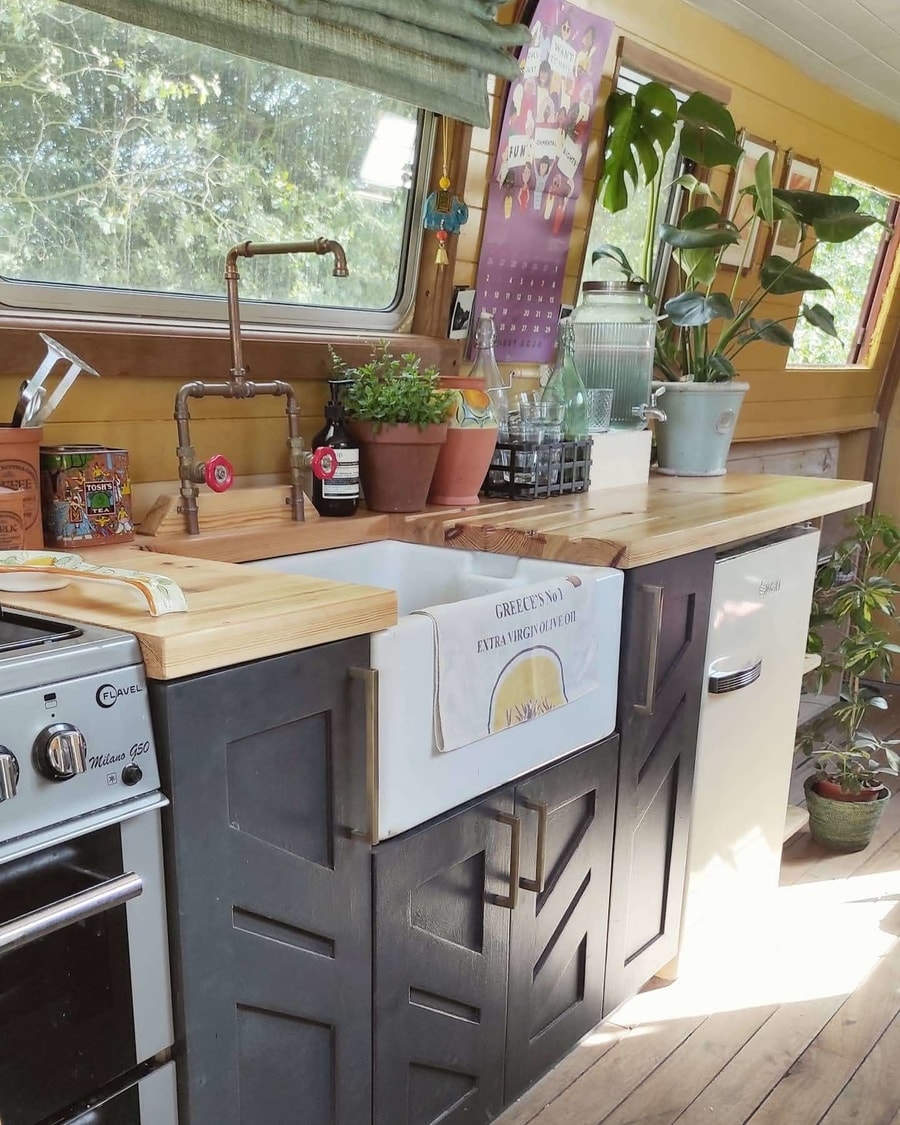
Images via @wood_and_water_blog/Instagram
I love when tiny places make space for green things!
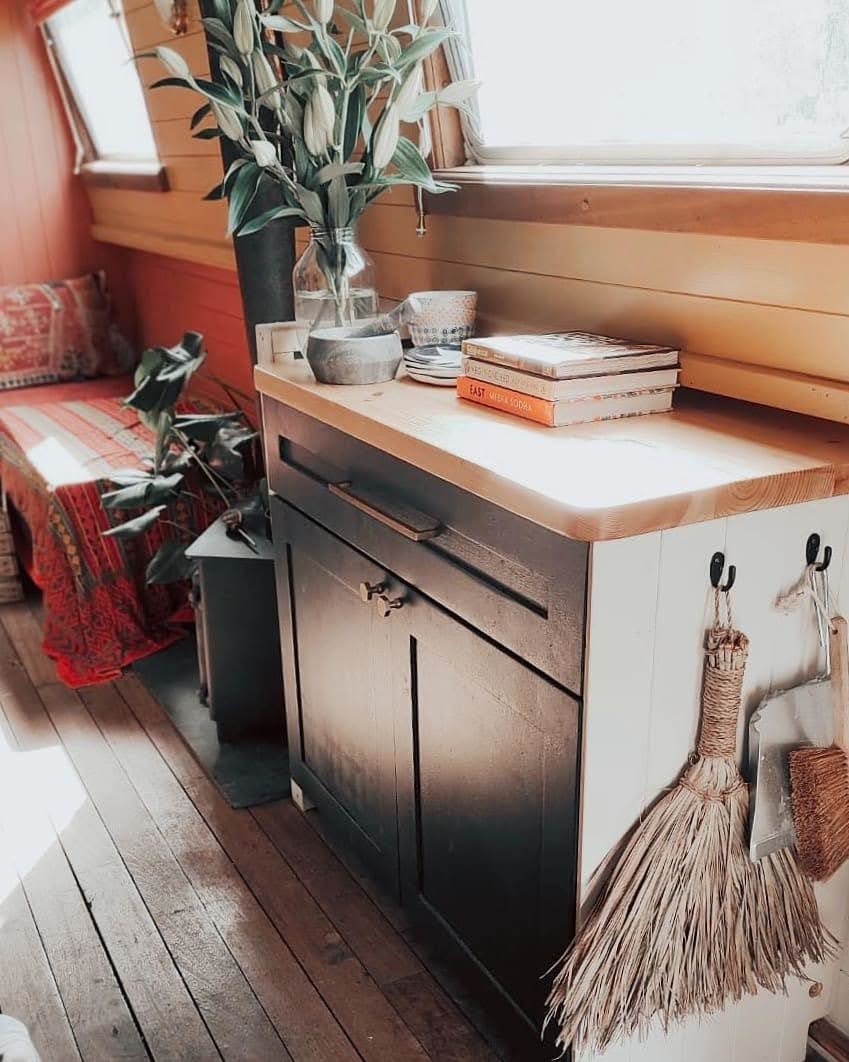
Images via @wood_and_water_blog/Instagram
Corner couch and a guitar.
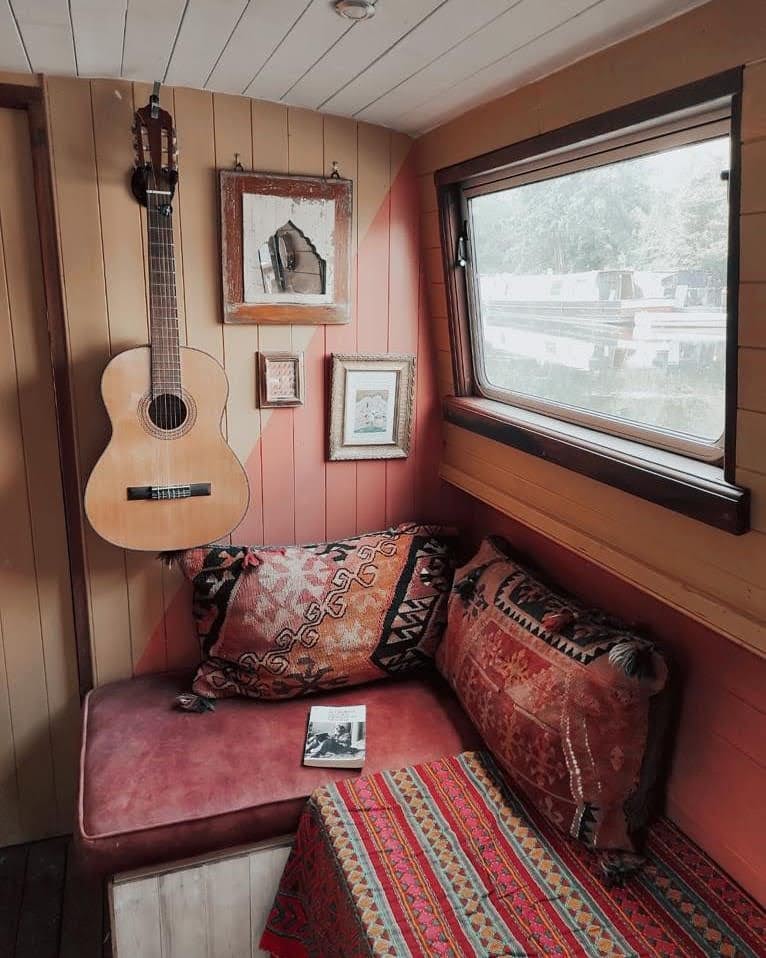
Images via @wood_and_water_blog/Instagram
Now that’s a bedroom to envy!
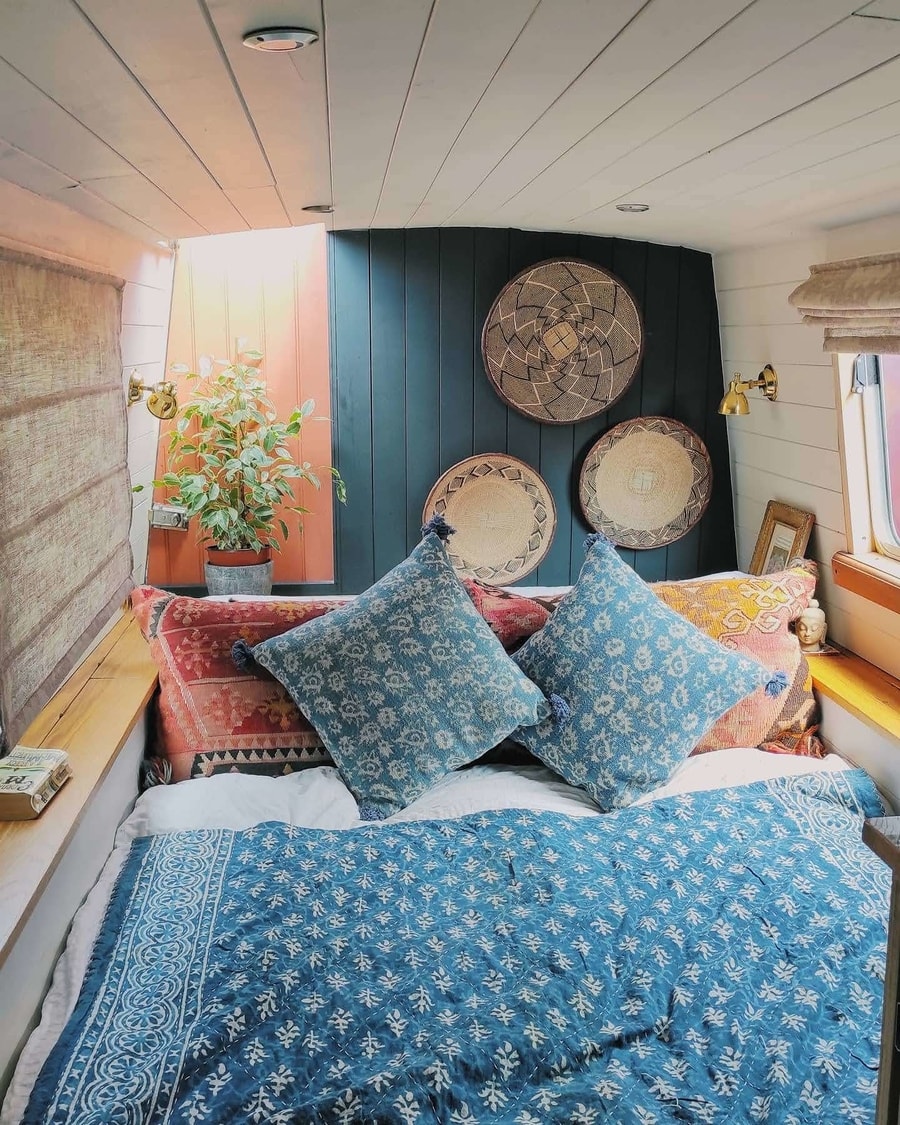
Images via @wood_and_water_blog/Instagram
They made their tiny bathroom look fantastic.

Images via @wood_and_water_blog/Instagram
Quite a large shower stall!

Images via @wood_and_water_blog/Instagram
Jessica & Al’s Canal Life
Hey Tiny House Talk! We are Jess and Al – we live together on our tiny floating home Peace Frog. We both live and work in London, Al as a carpenter and Jess in PR. Our tiny living set-up enables us to live alternatively, with some of the adventure of travelling and with a low carbon footprint, whilst also working full time and enjoying living in a city.
Our home, Peace Frog, is a 55ft long narrowboat which we have owned for two years. We haven’t lived on Peace Frog solidly for two years though– as last year we had a fire which meant we had to move off for a short time. It was really sad, but it was also a blessing as it gave us the opportunity to re-design and re-build the whole boat from scratch! Al had a very busy lockdown gutting and modernising the whole boat and it’s looking better than ever. We’re now back to continuously cruising Peace Frog on the London canals, moving every two weeks.
To be a continuous cruiser means you can moor nearly anywhere on the cut and don’t have to pay a mooring fee, however you do have to demonstrate you are on a genuine journey, navigating a minimum of 20 miles a year as part of the deal.
The travelling is one of our favourite aspects of tiny living. We have a new neighbourhood every second week which allows us to explore new areas, meet new neighbours and get to know every square foot of London in a way which we never could when living on dry land. Every time we come to move on, we get excited about where we might end up next.
The London waterways can get busy, so finding a spot usually entails spotting a gap and going for it! If we’re cycling along the canals to and from work, we’ll always keep an eye out for a great spot which has come free.
We’ve always been drawn to the canals. When we rented, we always found ourselves seeking the tow paths on the weekend and the reassuring calm which they offered in contrast the city. The absence of traffic and coming together of nature and community feels like such a special place.
We love the alternative lifestyle, the sense of adventure and the autonomy owning a boat gives us. There are certainly downsides to boat life too, which, similar to van living, mainly concern ensuring you have the baseline supplies for living, such as water, electricity and warmth – as well as a functioning engine so you can move. We are off grid, so keeping your water, gas and fuel for your engine topped up can be really time consuming.
Since we renovated the boat, we’ve put in central heating, a new cooker, a hot water tank, plumbing and double-glazed windows, so this winter has been so cosy compared to the last!
The renovation works also included a whole new fit out and electrics. All in all, it cost us around £20k and we did all the work ourselves. Most of our budget went on the less glamourous jobs like getting the boat insulated and the new windows, so when it came to décor and interior styling we’ve upcycled and bought second hand where possible.
The cost to run a boat month to month is very minimal– we put aside around £200 a month to cover things like diesel and gas and water is free on the tow path. We pay a yearly fee to the Canal and Riverside Trust of around £1,000 and the boat insurance is about £400 a year. This is a huge drop from the rent we used to pay in London which was around £1,000 a month. That said, the boat comes with lots of hidden costs, so whilst bills might be low, we often need to fork out bigger one-off payments to maintain parts of the boat. For instance, our engine has broken down a lot recently which resulted in some big bills! We keep an emergency kitty for unseen costs like these.
With all tiny living, there are days which are harder and we’d certainly say life isn’t always simple. But we never wanted simple or easy, we wanted adventure and freedom, and the boat has certainly brought us that! We’re exploring a way of life that feels radical and unique which we wouldn’t change for the world.
Learn More:
Related Stories:
- Darcy Chose a Boat over a Mortgage & It’s Awesome!
- Couple Escapes London Rent With Narrowboat Cottage
- Small Space Living in a Narrowboat Tiny Home in London
Our big thanks to Jessica for sharing! 🙏
You can share this using the e-mail and social media re-share buttons below. Thanks!
If you enjoyed this you’ll LOVE our Free Daily Tiny House Newsletter with even more!
You can also join our Small House Newsletter!
Also, try our Tiny Houses For Sale Newsletter! Thank you!
More Like This: Tiny Houses | House Boats | Floating Homes | Q&As
See The Latest: Go Back Home to See Our Latest
This post contains affiliate links.
Natalie C. McKee
Latest posts by Natalie C. McKee (see all)
- 714 Sq. Ft. Cabin in the Woods - April 24, 2024
- Boho XL Tiny House with Shou Sugi Ban Siding - April 24, 2024
- Kentucky Tiny House in the Woods - April 24, 2024




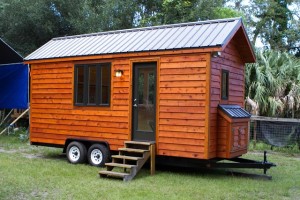

This is a great way to live and a fine looking boat. But at 55′, hardly a tiny house.
While long boats have great points, boats are charged for most everything by their length to dock, haul out, bottom paint, etc. Only if you anchor out or find a free place to tie up which is rare in the US does a very long boat make sense.
Note the boats, 2m? wide shows how that works so well with built in furniture boat style. In the US and technically it’s a canoe at that length and width and cheap to title, tag.
.
.
I’ll have to disagree that this isn’t tiny because tiny is relative, there isn’t a set standard for what is considered tiny that everyone will judge the same, and not everything should be judged the same way as a house anyway, especially with something that the space won’t always be used the same way like boats that can have very different designs from one to the next.
What’s considered a tiny home really depends on the size of the available living space and how it gets used. For example, what’s tiny for a family is not going to be the same for what’s tiny for one or two people. Along with other factors like how efficiently the space is used and what needs have to be met by it.
While having a large footprint won’t help if the actual living space is a much smaller percentage of that space… Even houses can have a much larger footprint than the actual living space. Among other factors that can effect the size of the living space, like space set aside for other needs, especially, for anything that needs to be self sufficient for off-grid living and being away from resources for periods of time.
So the boat size isn’t the only consideration… Besides, 55′ x 6′ 10″, actual dimensions of this boat, is still less than 362 Sq Ft for the footprint of the entire boat, never mind the living space within that dips below 300 Sq Ft… Well, within what most would consider tiny in the states…
Yes Jerry it doesn’t seem as easy to live on a boat in the US as it does in the UK where there are all those canalways.
We do have a good number of them, just bigger/wider plus so many rivers, lakes and the canals that connect them.
Generally you’d have a wider boat since not restricted to 1700s horse drawn canal specs.
And you don’t want to be caught in waves with a narrow boat as can be very uncomfortable.
You can take the intercoastal waterway/canal mostly from Texas to Maine back up the Hudson River though the Erie canal to Michigan then by canal to the Mississippi back down to Texas.
And some cool canals/rivers/lake chains coming off the Ohio River including ones going to the Gulf .
There are a lot more but there are plenty to last decades exploring at near no cost and certainly not the $1200/yr they pay for canal use.
Many every yr come down to Florida, Gulf by boat that in spring head back north using these. A great way to live.
Yes, a 55′ x 6’10” (length x width) boat definitely qualifies as a tiny house. Even if, after subtracting for the foredeck/bow and after deck/stern you measure the length of the cabin at 40’, living space is still less than 300 sq ft.
Nice,but I couldn’t live on a boat. I would constantly worrie about sinking.